3D Cell Culture Market Size
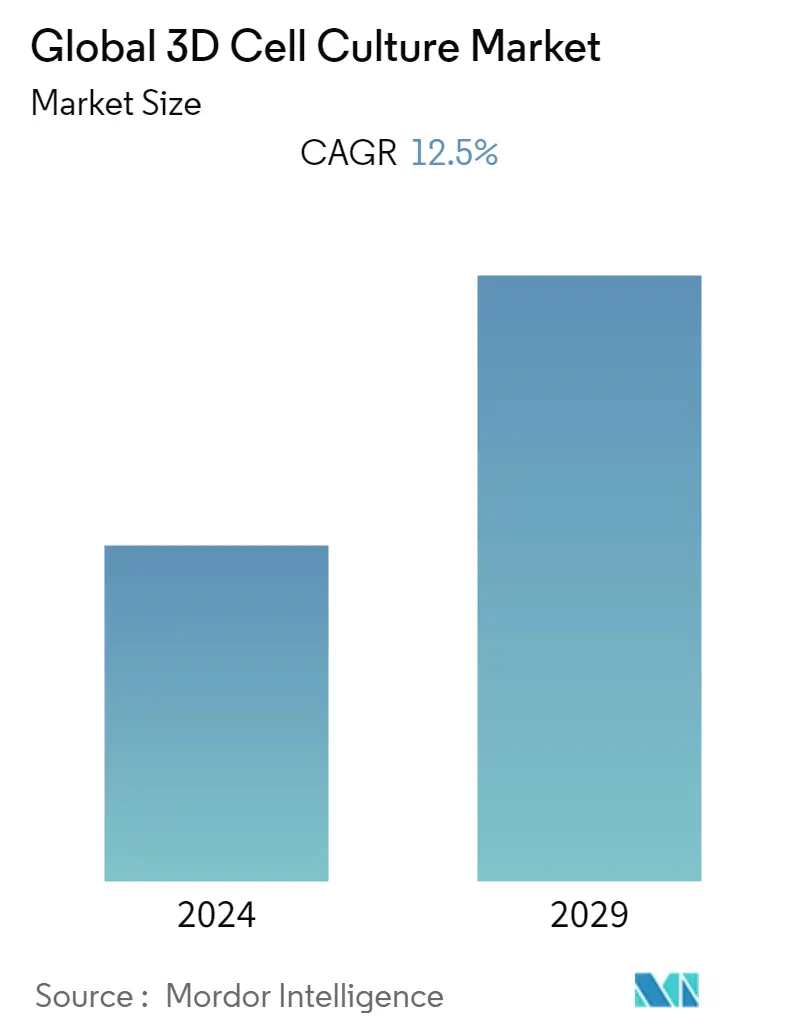
| Study Period | 2019 - 2029 |
| Base Year For Estimation | 2023 |
| Forecast Data Period | 2024 - 2029 |
| CAGR | 12.50 % |
| Fastest Growing Market | Asia Pacific |
| Largest Market | North America |
Major Players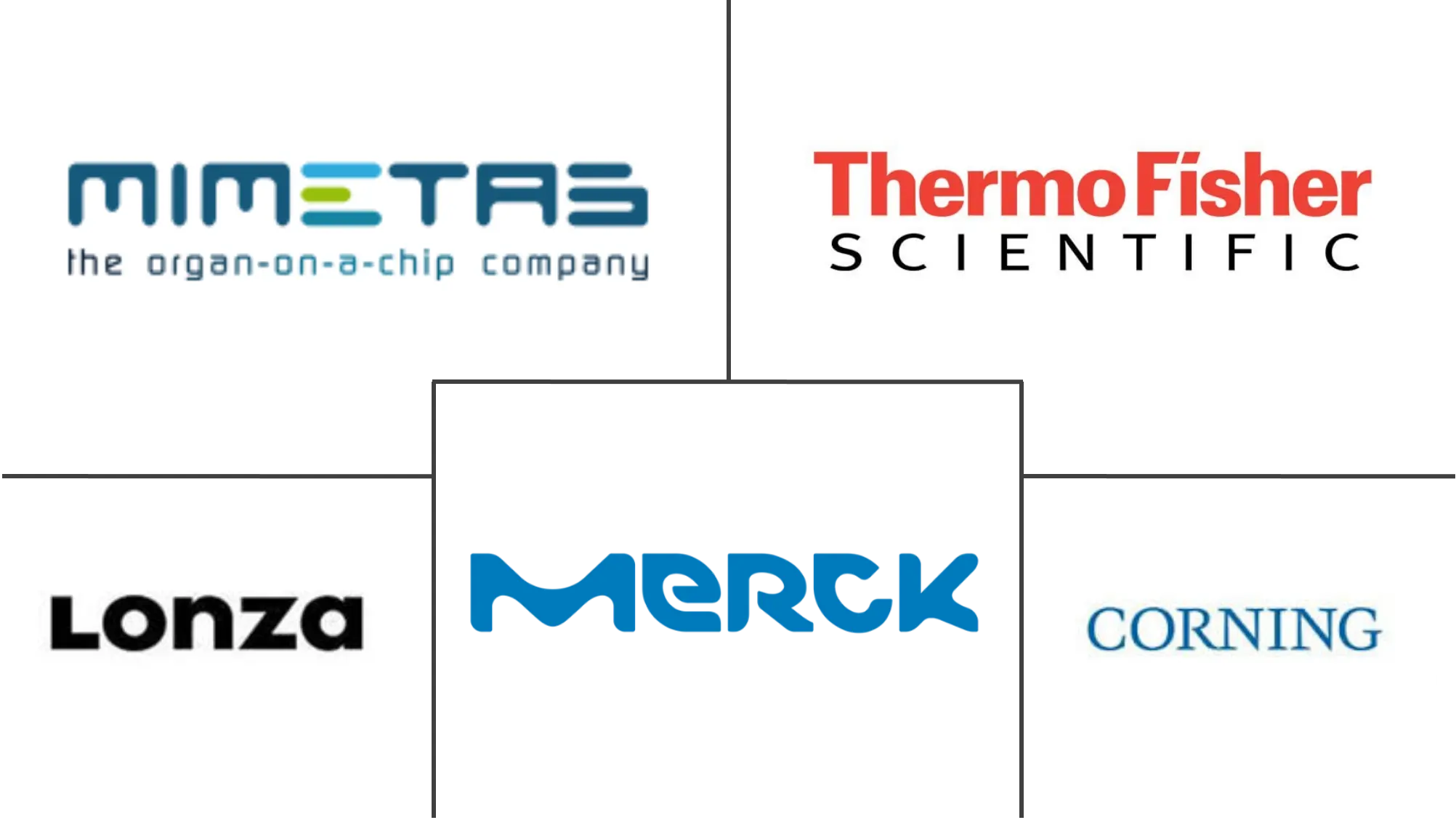
*Disclaimer: Major Players sorted in no particular order |
3D Cell Culture Market Analysis
The 3D cell culture market is expected to register a CAGR of 12.5% during the forecast period, 2022-2027.
The COVID-19 pandemic is expected to have a significant impact on the market. Researchers working on COVID-19 with relevant matrices for 3D cell culture and suitable for air-liquid interface culture need to investigate in vitro the mechanisms of the systemic consequences of cell cultures and to test potential therapies in a physiological microenvironment. This is the primary reason why 3D cell cultures are used in COVID-19 research. According to an article appearing in Frontiers Online in March 2021 titled, 3D Tissue Models as an Effective Tool for Studying Viruses and Vaccine Development, there are benefits of using 3D tissue culture techniques over 2D tissue culture when studying viral infections and the implications with regards to studying COVID-19. The study also found that techniques like organoids and spheroid cultures have been shown to replicate systems of viral infection more accurately than 2D cultures and to produce morphology and biochemical behaviors required to allow for viral infection in cases where 2D cultures do not.
The 3D cell culture market is witnessing stable growth due to factors like the use of 3D cell culture models as alternative tools for in vivo testing, the development of large-scale automated cell culture systems, and the rising need for organ transplantation. The 3D cell culture and co-culture models have huge benefits since they not only enable drug safety and efficacy assessment in a more in vivo-like context than traditional 2D cell cultures, but they can eliminate the species differences that pose limitations in the interpretation of the preclinical outcomes, by allowing drug testing directly in human systems. Additionally, with the increase in demand for organ transplantation, there is likely to be a demand for 3D cell cultures as there is a need to recapitulate complex aspects of human physiology, pathology, and drug responses in vitro. According to the organdonor.gov website of the United States Health Resources and Services Administration, in October 2021, 107,103 patients were on the national organ transplant waiting list in the year 2020. Data from the website also states that each year, 39,000 organ transplants are conducted in the United States. Thus, the increase in organ transplants is increasing the demand for research models where 3D cell cultures are used. This is expected to boost the market growth.
3D Cell Culture Market Trends
This section covers the major market trends shaping the 3D Cell Culture Market according to our research experts:
The Microchips Segment under Product is Expected to see Significant Growth Rate Over the Forecast Period
Microchips are also called organ-on-a-chip or microsystems. Microchips can integrate microfluidic technologies with cells that are cultured within the microfabricated 3D devices, using various techniques from the microchip industry. For instance, the study published in the Analytical Methods in June 2019, titled Integrating 3D cell culture of PC12 cells with microchip-based electrochemical detection, identified that microchip was able to separate and detect dopamine and norepinephrine release. Thus, microchips fabricated with 3D cell culture devices help in the real-time analysis of neurotransmitters boost the segment over the forecast period.
2-dimensional (2D) culture models and animal models have been used for mechanism research and drug development. However, 2D models and animal models cannot mimic the physiology of human tissue in terms of the number of cell types and properties. Thus, conventional models cannot precisely reflect humans and have not been able to accurately predict in vivo responses related to drug treatment. In this regard, many industries have been looking for and developing a new platform to replace animal models or flask cell-culture models, and recently, organs-on-a-chip (OoCs) emerged as an alternative candidate for cell experiments and drug screening.
The main advantage of these chips is that they can be manufactured at a low cost. They allow for testing a wide range of concentrations in the dosage of medicine. This advantage is expected to drive the demand for microchips, primarily to considerably accelerate scientific research. In recent years, there have been innovative uses of organ chip technology for the drug discovery process. For example, in March 2019, the private space exploration company SpaceX announced that it plans to soon launch a Dragon cargo capsule that will contain four microchips embedded with living human cells designed to model various aspects of human physiology. This is expected to speed up analysis and glean insights on human physiology that can be used later for drug development.
As a result, due to the aforementioned advantages and research in microchips, 3D cell culture technologies are expected to drive the market's growth.
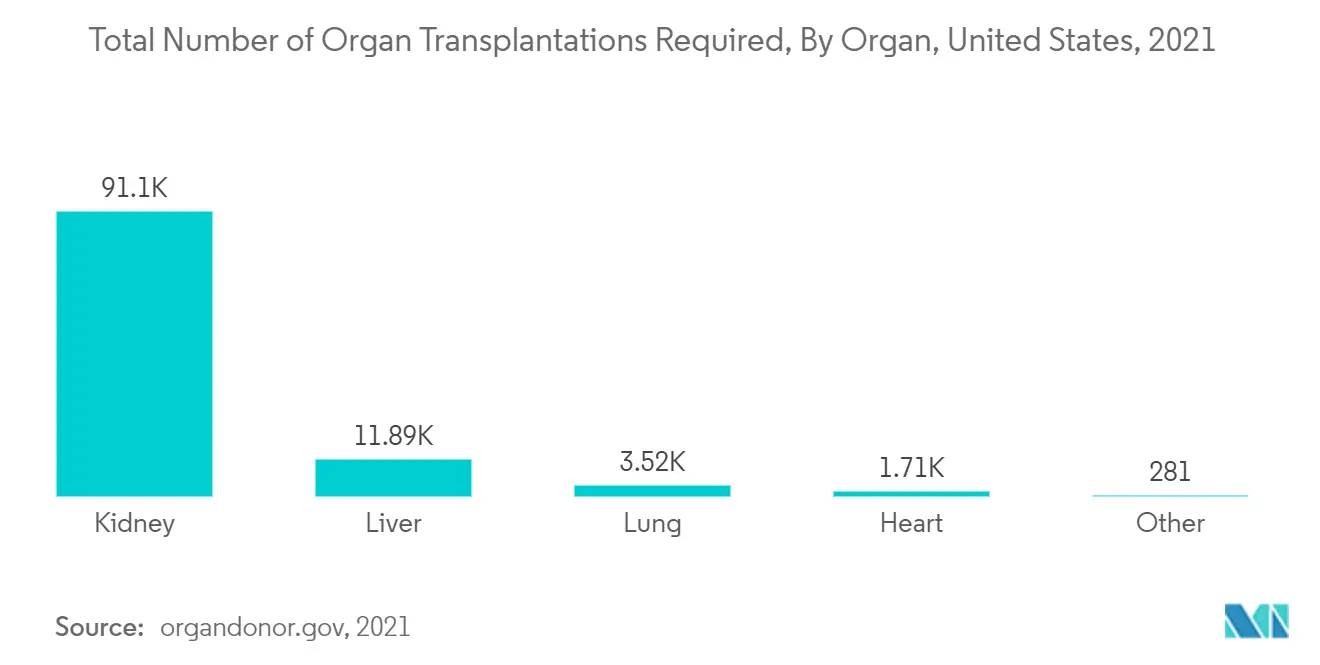
North America Captured the Largest Market Share and is Expected to Retain its Dominance
North America dominates the overall 3D cell culture market, with the United States being the major contributor to the market. The United States is focusing on R&D and has been making significant investments in research on 3D cell culture for the past few years. This has resulted in technological advancements in the country. Many American applicants feature among the main patent applicants for the 3D cell culture domain. American applicants tend to develop their technologies in the United States, as well as in Asia.
There have also been huge investments in the bioengineering sector in the United States over the past few years. Bioengineeringinvolves 3D cell culture research too. According to the National Institute of Health, in 2020, the total investment in various bio engineering technologies amounted to USD 5,646, an increase from USD 5,091 in 2019. These factors have augmented the US 3D cell culture market.
Moreover, there is a need to mimic intricate elements of human physiology, pathology, and medication reactions in vitro. There is expected to be a demand for 3D cell cultures as the demand for organ transplantation grows in the region. According to the Canadian Institute for Health Information, in 2021, a total of 3,014 transplant procedures (all organs) were performed in Canada (including Quebec), an increase of 42% since 2010. Thus, all the aforementioned factors are expected to boost the market in the region over the forecast period.
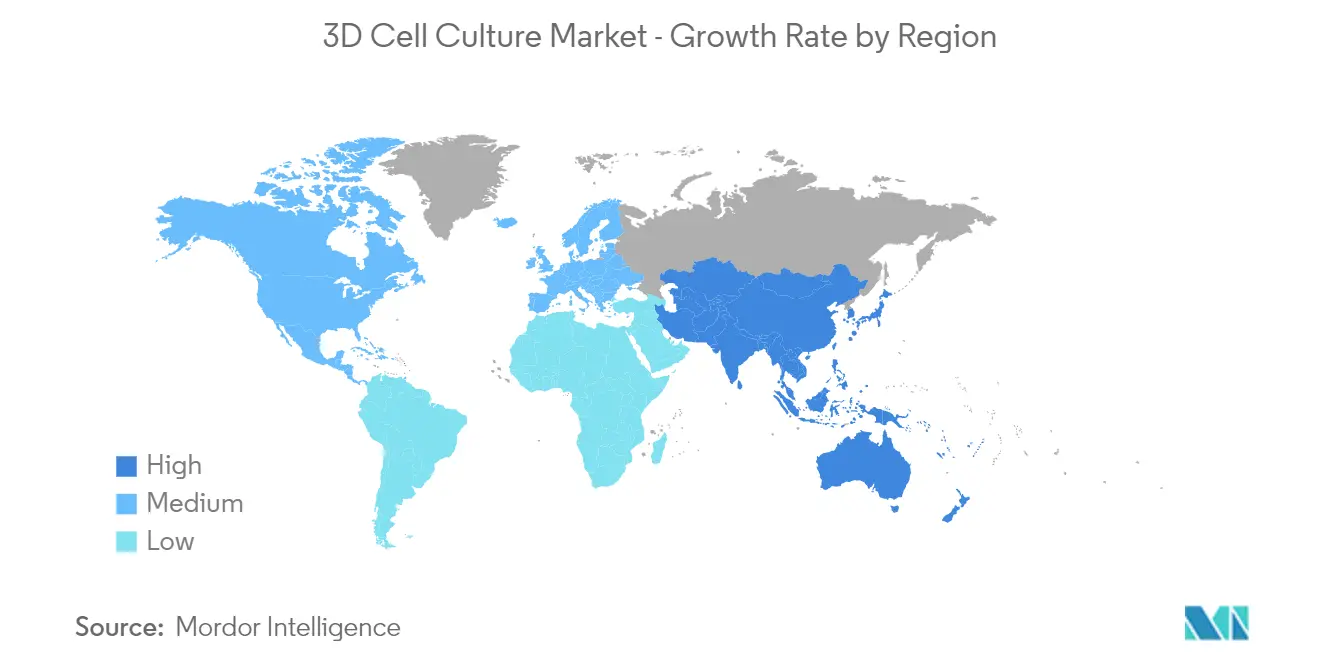
3D Cell Culture Industry Overview
The 3D cell culture market is highly competitive and consists of several major players. In terms of market share, few of the major players currently dominate the market. The presence of major market players, such as Corning Incorporated, Lonza AG, Merck KGaA, and Thermo Fisher Scientific, is increasing the overall competitive rivalry in the market.
3D Cell Culture Market Leaders
-
Corning Incorporated
-
Lonza AG
-
Thermo Fisher Scientific
-
Merck KGaA
-
MIMETAS BV
*Disclaimer: Major Players sorted in no particular order
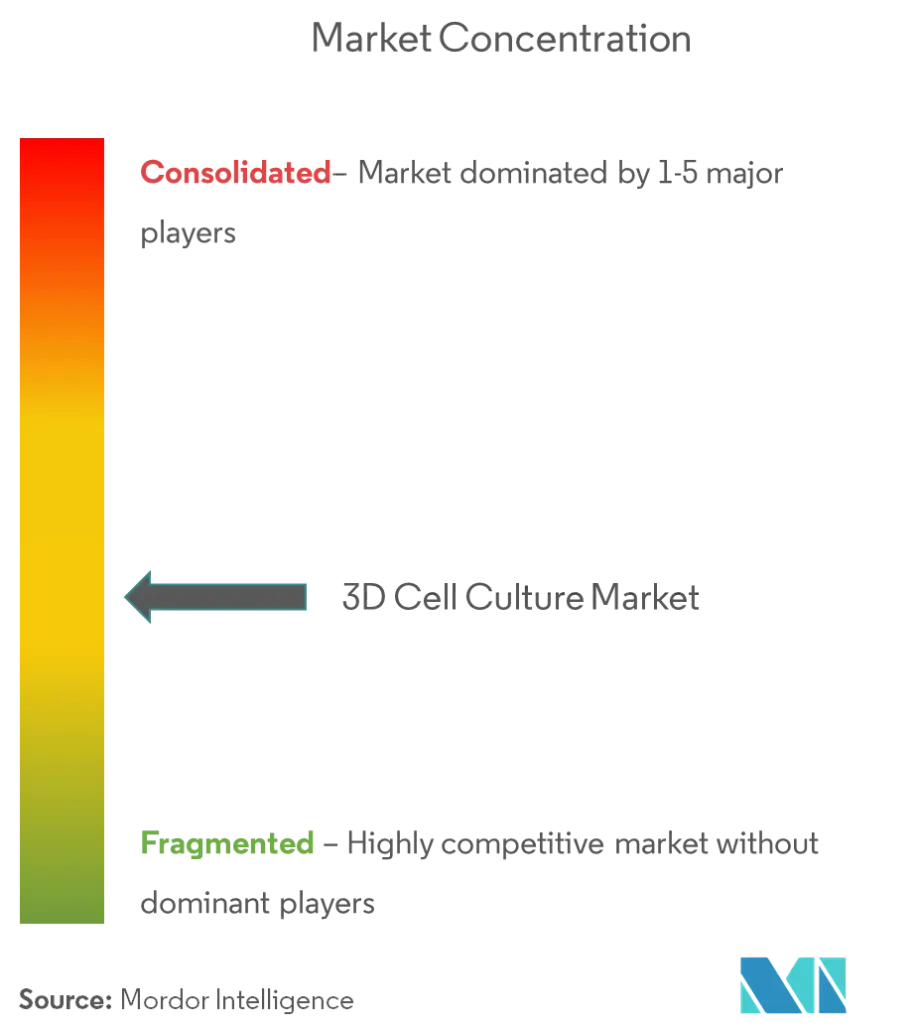
3D Cell Culture Market News
- In August 2021, Amerigo Scientific expanded its cell culture portfolio with the launch of 3D Cell Culture for scientific uses. This new 3D cell culture system can be used in research areas such as drug discovery, medicine, evaluation of nanomaterials, and basic life science.
- In January 2021, Jellagen Limited, a biotechnology company that manufactures high-value Collagen Type 0 derived from jellyfish, announced the launch of its JellaGel Hydrogel, a 3D hydrogel. JellaGel provides customers with a non-mammalian, natural, biochemically simple, consistent, and easy-to-use hydrogel that can transform their research.
3D Cell Culture Market Report - Table of Contents
1. INTRODUCTION
- 1.1 Study Assumptions and Market Definition
- 1.2 Scope of the Study
2. RESEARCH METHODOLOGY
3. EXECUTIVE SUMMARY
4. MARKET DYNAMICS
- 4.1 Market Overview
-
4.2 Market Drivers
- 4.2.1 Use of 3D Cell Culture Models as Alternative Tools for In Vivo Testing
- 4.2.2 Development of Automated Large-scale Cell Culture Systems
- 4.2.3 Rising Need for Organ Transplantation
-
4.3 Market Restraints
- 4.3.1 Lack of Experienced and Skilled Professionals
- 4.3.2 Budget Restriction for Small- and Medium-sized Laboratories
-
4.4 Porter's Five Forces Analysis
- 4.4.1 Threat of New Entrants
- 4.4.2 Bargaining Power of Buyers/Consumers
- 4.4.3 Bargaining Power of Suppliers
- 4.4.4 Threat of Substitute Products
- 4.4.5 Intensity of Competitive Rivalry
5. MARKET SEGMENTATION (Market Size by Value - USD million)
-
5.1 By Product
- 5.1.1 Scaffold-based 3D Cell Cultures
- 5.1.1.1 Micropatterned Surface Microplates
- 5.1.1.2 Hydrogels
- 5.1.1.3 Other Products
- 5.1.2 Scaffold-free 3D Cell Cultures
- 5.1.2.1 Hanging drop microplates
- 5.1.2.2 Microfluidic 3D cell culture
- 5.1.2.3 Other Products
- 5.1.3 Microchips
- 5.1.4 3D Bioreactors
-
5.2 By Application
- 5.2.1 Drug Discovery
- 5.2.2 Tissue Engineering
- 5.2.3 Clinical Applications
- 5.2.4 Other Applications
-
5.3 By End User
- 5.3.1 Research Laboratories and Institutes
- 5.3.2 Biotechnology and Pharmaceutical Companies
- 5.3.3 Other End Users
-
5.4 Geography
- 5.4.1 North America
- 5.4.1.1 United States
- 5.4.1.2 Canada
- 5.4.1.3 Mexico
- 5.4.2 Europe
- 5.4.2.1 Germany
- 5.4.2.2 United Kingdom
- 5.4.2.3 France
- 5.4.2.4 Italy
- 5.4.2.5 Spain
- 5.4.2.6 Rest of Europe
- 5.4.3 Asia-Pacific
- 5.4.3.1 China
- 5.4.3.2 Japan
- 5.4.3.3 India
- 5.4.3.4 Australia
- 5.4.3.5 South Korea
- 5.4.3.6 Rest of Asia-Pacific
- 5.4.4 Middle-East and Africa
- 5.4.4.1 GCC
- 5.4.4.2 South Africa
- 5.4.4.3 Rest of Middle-East and Africa
- 5.4.5 South America
- 5.4.5.1 Brazil
- 5.4.5.2 Argentina
- 5.4.5.3 Rest of South America
6. COMPETITIVE LANDSCAPE
-
6.1 Company Profiles
- 6.1.1 BiomimX SRL
- 6.1.2 CN Bio Innovations
- 6.1.3 Corning Incorporated
- 6.1.4 Hurel Corporation
- 6.1.5 InSphero AG
- 6.1.6 Lonza AG
- 6.1.7 Merck KGaA
- 6.1.8 MIMETAS BV
- 6.1.9 Nortis Inc.
- 6.1.10 Thermo Fisher Scientific
- 6.1.11 Sartorius AG
- 6.1.12 Promocell GmbH
- *List Not Exhaustive
7. MARKET OPPORTUNITIES AND FUTURE TRENDS
** Subject To Availablity3D Cell Culture Industry Segmentation
3-dimensional (3D) cell culture is an artificially created environment in which biological cells are permitted to grow or interact with their surroundings in all three dimensions. This report analyzes and discusses the 3D cell culture market. The 3D Cell Culture Market is segmented by Product (Scaffold-Based 3D Cell Cultures, Scaffold-Free 3D Cell Cultures, Microchips, and 3D Bioreactors), Application (Drug Discovery, Tissue Engineering, Clinical Applications, and Other Applications), End User (Research Laboratories and Institutes, Biotechnology and Pharmaceutical Companies and Other End Users), and Geography (North America, Europe, Asia-Pacific, Middle-East and Africa, and South America). The market report also covers the estimated market sizes and trends for 17 countries across major regions globally. The report offers the value (in USD million) for the above segments.
| By Product | Scaffold-based 3D Cell Cultures | Micropatterned Surface Microplates |
| Hydrogels | ||
| Other Products | ||
| By Product | Scaffold-free 3D Cell Cultures | Hanging drop microplates |
| Microfluidic 3D cell culture | ||
| Other Products | ||
| By Product | Microchips | |
| 3D Bioreactors | ||
| By Application | Drug Discovery | |
| Tissue Engineering | ||
| Clinical Applications | ||
| Other Applications | ||
| By End User | Research Laboratories and Institutes | |
| Biotechnology and Pharmaceutical Companies | ||
| Other End Users | ||
| Geography | North America | United States |
| Canada | ||
| Mexico | ||
| Geography | Europe | Germany |
| United Kingdom | ||
| France | ||
| Italy | ||
| Spain | ||
| Rest of Europe | ||
| Geography | Asia-Pacific | China |
| Japan | ||
| India | ||
| Australia | ||
| South Korea | ||
| Rest of Asia-Pacific | ||
| Geography | Middle-East and Africa | GCC |
| South Africa | ||
| Rest of Middle-East and Africa | ||
| Geography | South America | Brazil |
| Argentina | ||
| Rest of South America |
3D Cell Culture Market Research FAQs
What is the current Global 3D Cell Culture Market size?
The Global 3D Cell Culture Market is projected to register a CAGR of 12.5% during the forecast period (2024-2029)
Who are the key players in Global 3D Cell Culture Market?
Corning Incorporated, Lonza AG, Thermo Fisher Scientific, Merck KGaA and MIMETAS BV are the major companies operating in the Global 3D Cell Culture Market.
Which is the fastest growing region in Global 3D Cell Culture Market?
Asia Pacific is estimated to grow at the highest CAGR over the forecast period (2024-2029).
Which region has the biggest share in Global 3D Cell Culture Market?
In 2024, the North America accounts for the largest market share in Global 3D Cell Culture Market.
What years does this Global 3D Cell Culture Market cover?
The report covers the Global 3D Cell Culture Market historical market size for years: 2019, 2020, 2021, 2022 and 2023. The report also forecasts the Global 3D Cell Culture Market size for years: 2024, 2025, 2026, 2027, 2028 and 2029.
What are the key challenges hindering wider adoption of 3D Cell Cultures?
The key challenges hindering wider adoption of 3D Cell Cultures are a) High costs b) Complex protocols c) Limited standardization across platforms
3D Cell Culture Industry Report
The global 3D cell culture market is poised for substantial growth, driven by the shift towards alternatives to animal testing and a surge in demand for accurate biological models for research and drug development. This growth is supported by various end-users like biotechnology, pharmaceutical companies, and academic institutions. Advancements in tissue engineering and the push for personalized medicine are boosting the adoption of 3D cell cultures. Key market segments like scaffold-based cell cultures leveraging hydrogels and polymeric scaffolds are crucial due to their ability to mimic the extracellular matrix closely. Emerging technologies such as microfluidics-based and scaffold-free systems are gaining traction, enhanced by their support for high-throughput screening. Geographically, North America leads due to robust infrastructure and significant investment, while Asia-Pacific shows rapid growth due to increasing health concerns and biomedical advancements. Market leaders are focusing on strategic partnerships and new product developments to expand their 3D cell culture offerings. Get insights into these trends with a free report PDF download from Mordor Intelligence™ Industry Reports.



